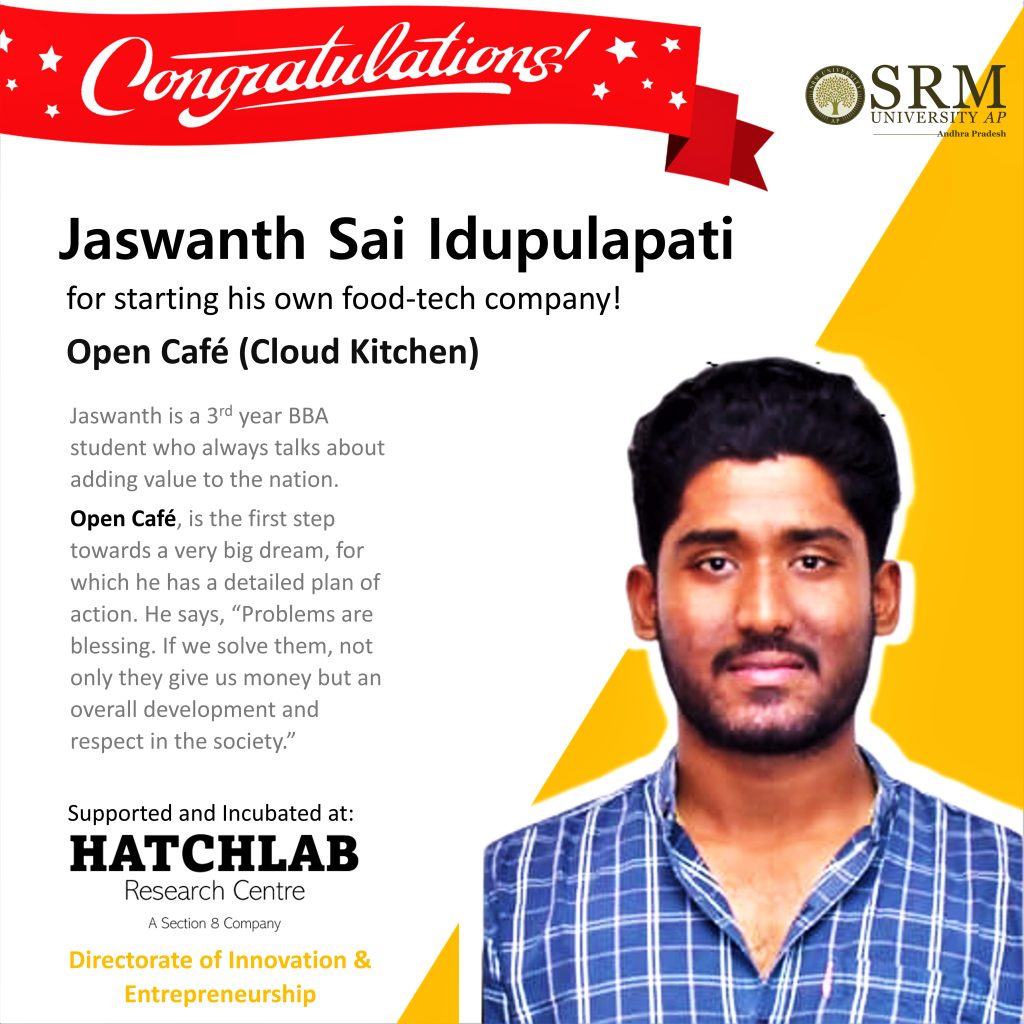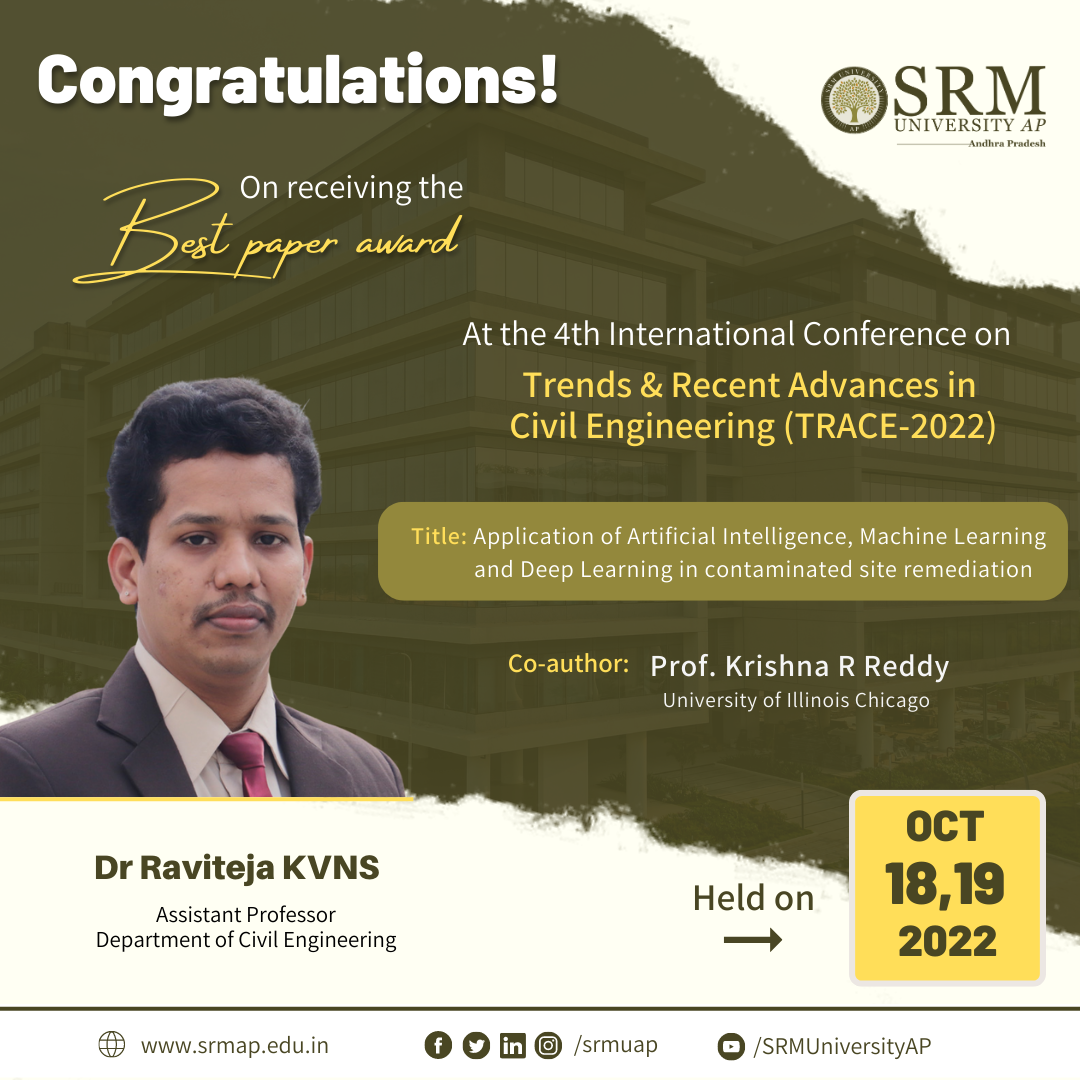- Successful Food-Tech Venture hoists Jaswanth to Newer Heights! December 19, 2022

“The best way to predict the future is to create it”. Jaswanth Sai has proved to be a living and breathing manifestation of this quote with his determination and hard work. The Directorate of Entrepreneurship and Innovation is pleased to announce that Jaswanth Sai Idupulapati, a 3rd year BBA student, has successfully started his own food-tech company, Open Cafe, a cloud kitchen enterprise. Cloud kitchens are centralised, licensed commercial food production facilities where one to dozens of restaurants rent space to prepare delivery-optimised menu items. Jaswanth, an enthusiastic student of the Hatchlab Research Centre had started his business with an investment of Rs. 5000/- and today his turnover is more than 20L per month for a business that was started just three months ago!
“We invested Rs. 5000 and brought a van full of biriyani outside the main gate of our university. Hours passed and not a single sale happened. Those moments were not only depressing but also terribly demotivating. But as a leader, I had to rise up! We immediately changed the pricing strategy and shared the same via WhatsApp groups. In the next 45 minutes, we were left with empty vessels and a handful of cash. Profit was less; the learning and our confidence levels were mountain high,” Jaswanth excitedly mentioned about his first day of business.
As of now, Open Cafe caters to more than 1000+ students from SRM AP and VITAP, with quality food items that are delivered with a caption – 15 minutes delivery. Jaswanth has 15 employees and a big renovated kitchen, generating employment and thousands of satisfied customers.
His dedication and hardcore willpower allowed the materialisation of his idea into reality. Congratulations to Jaswanth Sai for his astonishing achievement!
Continue reading → - Dr Raviteja KVNS Received the Best Paper Award at TRACE 2022 December 16, 2022
 Soil and groundwater contamination is closely interlinked with human society because of its direct impact on population health and socioeconomic activities. The design and implementation of site remediation can be expensive, time-consuming, and may require much human effort. Emerging technologies such as Artificial Intelligence, Machine Learning, and Deep Learning have the potential to make site remediation cost-effective with reduced human effort.
Soil and groundwater contamination is closely interlinked with human society because of its direct impact on population health and socioeconomic activities. The design and implementation of site remediation can be expensive, time-consuming, and may require much human effort. Emerging technologies such as Artificial Intelligence, Machine Learning, and Deep Learning have the potential to make site remediation cost-effective with reduced human effort.Assistant Professor Dr Raviteja KVNS, Department of Civil Engineering, has received the Best Paper Award at the Fourth International Conference on Trends and Recent Advances in Civil Engineering (TRACE) 2022 for his paper Application of artificial intelligence, machine learning and deep learning in contaminated site remediation. The conference was held at Amity University, Uttar Pradesh, on October 18 and 19, 2022. His research reports the applications of AI and ML in contaminated site remediation.
Dr Raviteja’s future research plan includes studying potential applications of various AI, ML and DL techniques for Geotechnical and Geo-environmental design and testing applications so as to reduce the labours of physical and repetitive testing and associated human effort. This further improves precision as well as aids in decision-making. He has collaborated with Prof. Krishna R Reddy, University of Illinois Chicago, for this research work.
Abstract
Soil and groundwater contamination is caused by improper waste disposal practices and accidental spills, posing a threat to public health and the environment. It is imperative to assess and remediate these contaminated sites to protect public health and the environment as well as to assure sustainable development. Site remediation is inherently complex due to the many variables involved, such as contamination chemistry, fate and transport, geology, and hydrogeology. The selection of remediation method also depends on the contaminant type and distribution and subsurface soil and groundwater conditions. Depending on the type of remediation method, many systems and operating variables can affect the remedial efficiency. The design and implementation of site remediation can be expensive, time-consuming, and may require much human effort. Emerging technologies such as Artificial Intelligence, Machine Learning, and Deep Learning have the potential to make site remediation cost-effective with reduced human effort. This study provides a brief overview of these emerging technologies and presents case studies demonstrating how these technologies can help contaminated site remediation decisions.
- Dr Md Faiz Ahmad December 16, 2022
- EEE Students Visited Dr Narla Thatharao Thermal Power Station (NTTPS) December 16, 2022
 Industrial visit is an efficient learning strategy that nullifies the distance between academia and industry. Students and faculty of the Department of Electrical and Electronics Engineering visited Dr Narla Thatharao Thermal Power Station (NTTPS) on November 21, 2022. The objective of the visit was to give an overview of the Thermal Power plant, which is a coal-based power plant where coal is transported from coal mines to the power plant by railway in wagons or a merry-go-round system.
Industrial visit is an efficient learning strategy that nullifies the distance between academia and industry. Students and faculty of the Department of Electrical and Electronics Engineering visited Dr Narla Thatharao Thermal Power Station (NTTPS) on November 21, 2022. The objective of the visit was to give an overview of the Thermal Power plant, which is a coal-based power plant where coal is transported from coal mines to the power plant by railway in wagons or a merry-go-round system.The state-of-the-art construction and technologies amazed the students as they experienced an insightful industrial visit that exposed them to the actual working of a thermal power plant while enforcing their theoretical knowledge of Power Systems, Control Systems and Electrical Machines. Students from semesters one to four participated in the industry visit. Dr Somesh Vinayak Tewari, Dr Shubh Lakshmi, Dr Bhamidi Lokeshgupta, Dr Ramanjaneya Reddy U, and Dr Venkata Ramireddy Y were the faculty who accompanied the students.
A Detailed Account of the Industry Visit
 Coal is unloaded from the wagons using wagon tippler units to a moving underground conveyor belt. This coal from the mines is of no uniform size. So, it is taken to the Crusher house and crushed to a size of 20 mm. From the crusher house, the coal is either stored in dead storage, which serves as coal supply in case of coal supply bottleneck or to live storage in the raw coal bunker in the boiler house. Raw coal from the raw coal bunker is supplied to the Coal Mills by a Raw Coal Feeder. The Coal Mills or pulverizer pulverizes the coal. The powdered coal from the coal mills is carried to the boiler in coal pipes by high-pressure hot air. The pulverized coal air mixture is burnt in the boiler in the combustion zone.
Coal is unloaded from the wagons using wagon tippler units to a moving underground conveyor belt. This coal from the mines is of no uniform size. So, it is taken to the Crusher house and crushed to a size of 20 mm. From the crusher house, the coal is either stored in dead storage, which serves as coal supply in case of coal supply bottleneck or to live storage in the raw coal bunker in the boiler house. Raw coal from the raw coal bunker is supplied to the Coal Mills by a Raw Coal Feeder. The Coal Mills or pulverizer pulverizes the coal. The powdered coal from the coal mills is carried to the boiler in coal pipes by high-pressure hot air. The pulverized coal air mixture is burnt in the boiler in the combustion zone.Generally, in modern boilers, a tangential firing system is used where the coal nozzles/guns form a tangent to a circle. The temperature in the fireball is of the order of 1300˚C. The boiler is a water tube boiler hanging from the top. Water is converted to steam in the boiler, and steam is separated from water in the boiler Drum. The saturated steam from the boiler drum is taken to the Low-Temperature Superheater, Platen Superheater and Final Superheater, respectively, for superheating. The superheated steam from the final superheater is taken to the High-Pressure Steam Turbine (HPT). In the HPT, the steam pressure is utilised to rotate the turbine, and the resultant is rotational energy. From the HPT, the outcoming steam is taken to the Reheater in the boiler to increase its temperature as the steam becomes wet at the HPT outlet. After reheating, this steam is taken to the Intermediate Pressure Turbine (IPT) and then to the Low-Pressure Turbine (LPT). The outlet of the LPT is sent to the condenser for condensing back to water by a cooling water system. This condensed water is collected in the Hot well and sent to the boiler in a closed cycle. The rotational energy imparted to the turbine by high-pressure steam is converted to electrical energy in the Generator.
Continue reading → - Aloha 2022: The magnificent fresher’s day celebration at SRM AP December 15, 2022
 Senior students of SRM University-AP received the newcomers with a grand welcome party on November 25 and 26, 2022. The two-day-long celebrations were immaculate and encapsulated the radiant aura of the new-age university.
Senior students of SRM University-AP received the newcomers with a grand welcome party on November 25 and 26, 2022. The two-day-long celebrations were immaculate and encapsulated the radiant aura of the new-age university.Enthralling games, incredible performances, mouth-watering food stalls, booming music, and the brightest grins precisely describe Aloha 2022, the fresher’s day celebrations. Newcomers were welcomed to the festivity of SRM AP with the warmest colours and loudest cheers!
Honourable Vice Chancellor of SRM University- AP, Prof Manoj K Arora, inaugurated the event and asked the students to fully revel in the celebrations. All the faculty, staff and leadership members were also present at the festive occasion to welcome the brand-new batch of students to the campus.
A wide array of entertainment programmes was organised as part of the wholesome event. Students took over the stage by dancing to hype songs and singing their hearts out on both days of the event. The highlight of the event’s second day was the Mr&Ms Freshers contest. The vibe of the fresher’s party reached its peak with the vibrant DJ party filled with loud cheers and solid beats.
Cubing context, Tug of war, crossword, pop culture quiz, bucket game, water race, and many other fun games were also arranged beside the on-stage performances, which kept the students engaged on the two days of the celebrations. The food festival featuring mouth-watering street foods added flavour to the already colourful festival.
Continue reading →

